American Fisheries Act
Regulations rationalizing and governing trawl fisheries in the Bering Sea. See here for more.
Auxiliary Engine
An engine that runs a generator to provide electrical power on the boat.

Bairdi Crab
A species of tanner crab related to opilio snow crab. Sometimes also called snow crab. Prized for its distinctive sweet flavour. Click here for more.
Bait Chopper
A hydraulic drum with sharp blades that grinds frozen blocks of herring.

Block
A hydraulic device for hauling pots.

Blue King Crab
In Alaska, blue crab live around St. Matthew Island and the Pribilof Islands. They turn red when cooked and most American consumers cant tell the difference between blue, red or golden king crab, either by sight or by taste. Click here for more information.
Boat or ship?
Boneyard
Another name for graveyard. Crab fishermen use it to describe an area without crab.
Bow Thruster
A propeller in the bow that helps a boat maneuver.
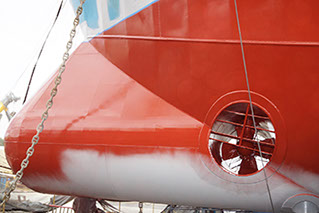
Brailer
These offloaders are throwing crab into a brailer.

Bulkhead
A wall on a boat, especially around the deck. This bow is surrounded by a bulwark. Some might say the bow is surrounded by bulwarks. I don't care either way.
Bulwarks
A wall around the deck. This bow is surrounded by a bulwark. Some might say the bow is surrounded by bulwarks. I don't care either way.
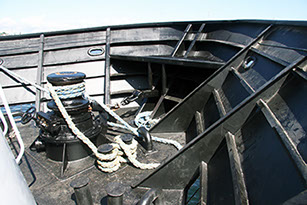
Chafing Gear
Material fastened to the bottom of a cod end or net to protect it from abrasion. In the photo it's the orange stuff on the cod end.
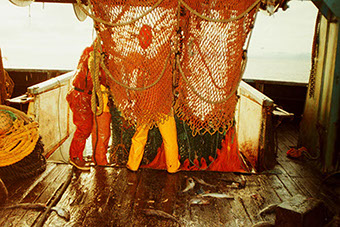
Charter
A contract with a government agency or private party to use a boat for some purpose.
Choke Strap
A heavy wire used to choke off the top of cod end in preparation for transfer.
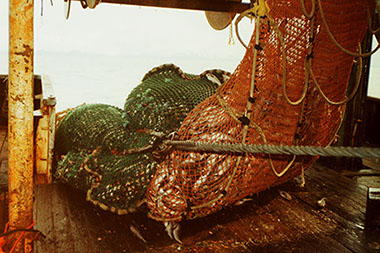
Cod End
The detachable end of the net.

Coiler
A hydraulic machine that coils crab line.
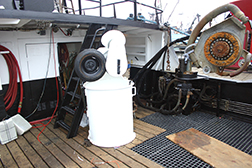
Crane
Most Bering Sea fishing vessels have a deck crane or two.
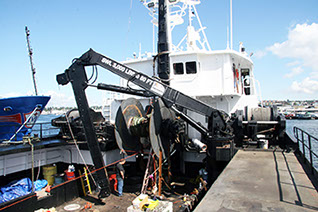
Crows Nest
Almost no Bering Sea fishing vessels have a crows nest.
It has to be pretty nice weather to go up in one of these.
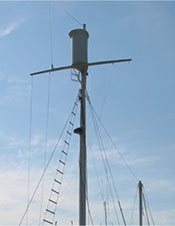
Dead Reckoning
An old fashioned method of navigation by guessing
Deck
A boat version of a floor. Many fishing boats and all crab boats have a wood wear deck over the steel deck. This crab boat deck has some snow on it.
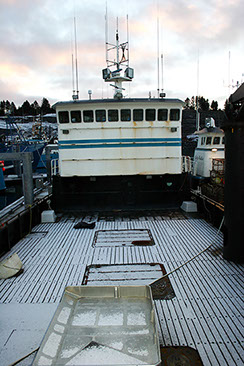
Deckhead
A ceiling on a boat. This control station has instruments and radios attached to the deckhead.
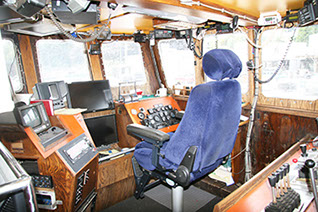
Dog
A device that prevents a winch from slacking out. On a launcher, dogs are moved hydraulically over the bars of the pot to keep in on the launcher when the pot is emptied. Notice the extensions on each side of the top of the launcher. Each extension has a slot. The dogs are hook-like structures that come out of the slots and clamp over the bottom bars of the pot. The lawn chairs are because this crab boat was preparing to go tendering and the crew was getting ready to relax.
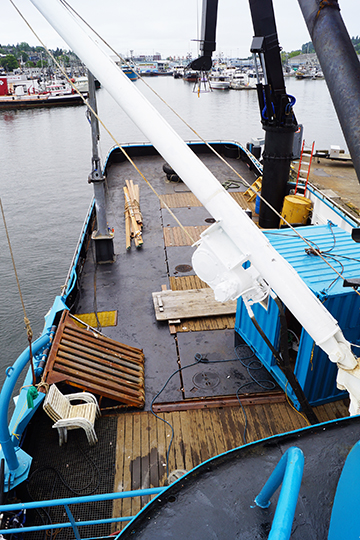
Following Sea
When the boat travels the same direction as the waves.
Fo'c's'le
An enclosed area of the bow usually referred to as the forepeak by Bering Sea sailors. In the photo the forepeak is forward of the bulkhead. If you climbed the pretty blue ladder you would stand on the fo'c'sle head.
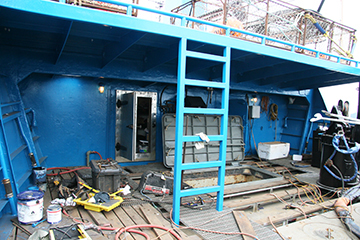
Free Surface Effect
Partially filling this crab tank causes the water to stack up on one side when the boat rolls, reducing stability and sometimes causing boats to roll over.
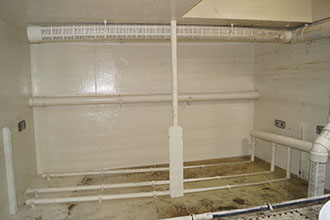
Gale
Strong winds, but officially winds between 34 and 47 knots. The top of a boat is visible behind a wave.
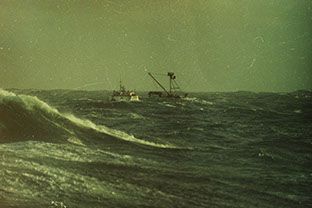
A typical Bering Sea forecast:
...GALE WARNING THROUGH TONIGHT...
Synopsis: A 994 MB LOW 160 NM NORTH OF SHEMYA WILL DRIFT TO 110 NM NORTH OF SHEMYA THIS AFTERNOON AND DISSIPATE. A 962 MB LOW 310 NM SOUTHEAST OF SAND POINT MOVES TO NEAR SAND POINT EARLY THU AND MAINTAINS STRENGTH... THEN MOVES TO 90 NM NORTH OF SAND POINT AT 967 MB FRI MORNING.
Today NE wind 40 kt. Seas 13 ft. Rain.
Tonight NE wind 35 kt. Seas 13 ft. Rain.
Thu N wind 20 kt except E 30 kt from port moller E. Seas 10 ft. Rain.
Thu Night N wind 30 kt. Seas 7 ft.
Fri SW wind 25 kt. Seas 9 ft.
Sat SE wind 20 kt. Seas 6 ft.
Sun N wind 25 kt. Seas 6 ft.
Gear
Gear can refer to a lot of things on the boat, including fishing equipment. The Autumn Dawn stacks gear in Dutch Harbor.
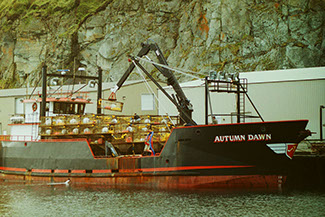
Gilson
A strong winch for hauling cod ends onto the deck. This gilson winch has a hook like the one that fell out of the chock strap when a large see took me overboard. See Chapter 9.
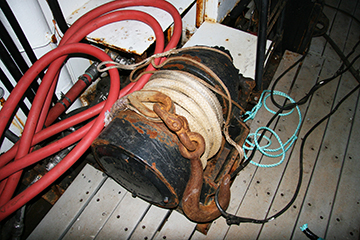
Golden King Crab
A deep water crab with longer, skinnier legs than its red or blue king crab cousins. Find out more here.
Hawser
A heavy line used for mooring or other purposes requiring a strong line. See more here.
Helm
Means of turning the rudders. See more here. This wheelhouse has a manual helm (wheel) as well as electro-hydraulic steering.
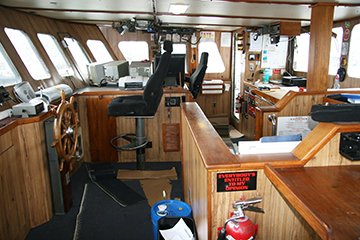
Hook
In crab fishing a hook is a small grapple used to retrieve buoy line. It is an iconic symbol of crab fishing as illustrated by the Bering Sea Alaska Crabbers logo.
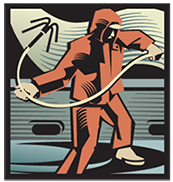
ICE
Frozen water - or the largest crab harvesting cooperative in the Bering Sea fisheries.
.jpg)
IFQ
Individual Fishing Quota. See here for more.
IPQ
Individual Processing Quota. See here.
Jewelry
The shackles and wires used for transferring a cod end. The photos shows some jewelry on a trawlers deck.
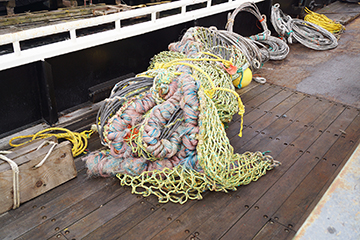
Jog Stick
A lever for steering. This modern longliner has the jog stick on the arm of the captain's chair.
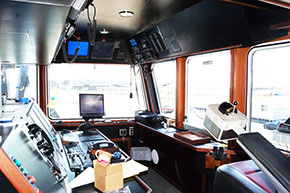
Jogging
Making way with just enough speed to maintain steerage.
Joint Venture
In fishing, American harvesting vessels delivered to foreign processing ships, barred from fishing themselves. Here a South Korean trawler pulls up 55-tons of pollock caught by the Pelagos.

Launcher
A launcher dumps a crab pot over the bulwark. This launcher is covered with ice.
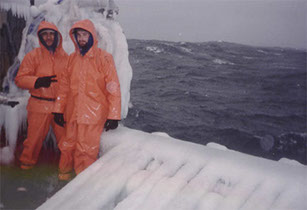
Line or Rope?
Rope is for cowboys. Fishermen use line. That's all I have to say about it.
Loran
A navigation system using the triangulation of radio waves. It is no longer used in the Bering Sea and the transmission stations have been deactivated.
The Magnuson-Stevens Act
Main Engine
The primary propulsion engine (s). Fishing boats typically have one or two.

Net Reel
A hydraulic drum on the deck of a trawler that sets, hauls, and stores nets. Most Bering Sea trawlers have two or three net reels.


Opilio Crab
A species of tanner crab. Typically called a snow crab.
Pelican Hook
A hook that can be released while carrying a load. A pelican hook is at the end of the chain in the photo below. See more here.
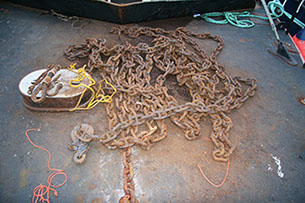
Red King Crab
The king of all crabs. See more here.

Running
Synonymous with travelling. Examples: A boat is running to the next sting. There is a 30-hour run to the gear. Below, the Kevleen K is leaving Dutch Harbor. It has a 1 day run to the king crab grounds.
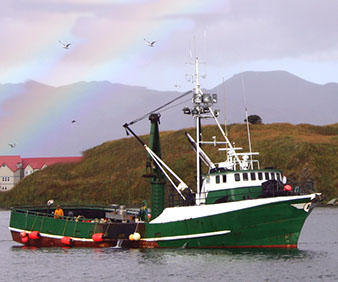
Schooner
A boat with the house on the stern. The Lady Alaska is a schooner.

Sea Lion Buoy
A round Polyfoam float used in days past at the end of the crab line. Called a sea lion buoy because sea lions can't pop them. If the air-filled buoys are cut off or damaged, the sea lion buoy often remains. They are good for fishing in heavy tides as don't flatten like air buoys sometimes do. In the photo the smaller, rounder buoy is the sea lion buoy.
.jpg)
Ship
A big boat. See "Boat or Ship" above.
Shot
A length of line or chain. Crab pots use two shots of line, one that floats and one that sinks. The floating line keeps it off the pot. The sinking line keeps the line off the surface. Each type helps prevent damage to the line and resulting lost pots. Below, an eagle guards the shots of line in a pot.
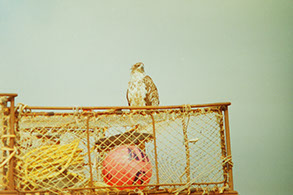
Single
A simple boom and winch assembly with one hoist wire or line. The picking boom on a crab boat, like the one in the photo, is a single.

Single Screw or twin screw
Having one propeller (single) or two (twin). Below, the Northwestern has a single screw while the Alaskan Leader is twin screw.


Snow Crab
A group of crabs including bairdi, opilio and their relatives. Click here for more.
Soak
The amount of time a pot is left on the bottom to fish. A common excuse to sleep.
Squall
A patch of worse weather More here.
Stack
Crab pots on deck. "Stacking gear" is putting pots on deck to make a stack. The Sea Star puts a stack on.

Storm
Storm force winds are from 48 to 63 knots. Fishermen refer to any winds stronger than that as a storm as well. See here.
String
A line of crab pots with no particular number of pots.
Swim bladder
A gas filled organ of some fishes. See here for more.
Tank Check
An Alaska Department of Fish and Game person looks into each crab tank to make sure no pre-season fishing was done. There is no crab in this tank on the Bristol Mariner.

Tanner Crab
Snow crab. See here.
Tendering
Transporting fish from a harvesting boat to a processor. The Kathleen K is a tender.
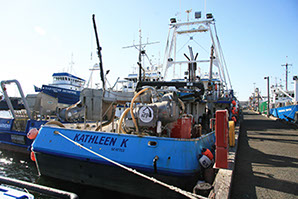
Third Wire
A coaxial cable that runs from the boat to a transducer on the headrope of the net. The cable is spooled on a third wire winch seen in the photo below.

Trawl
A type of net towed behind the boat. See here.
Trawl Door
Steel planes that open the net. The green things on the stern of this Korean trawler are the doors.
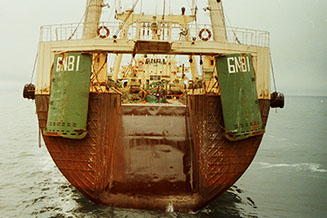
Twin Screw
See "Single Screw" above.
Watch
Taking a turn driving the boat. More here.
Web
The mesh fabric from which nets are made.

Winch
A pulling or lifting device. In the Bering Sea most winches are hydraulically powered. The photo below shows a typical trawl winch.

Copyright 2016 Masende, LLC All Rights Reserved.